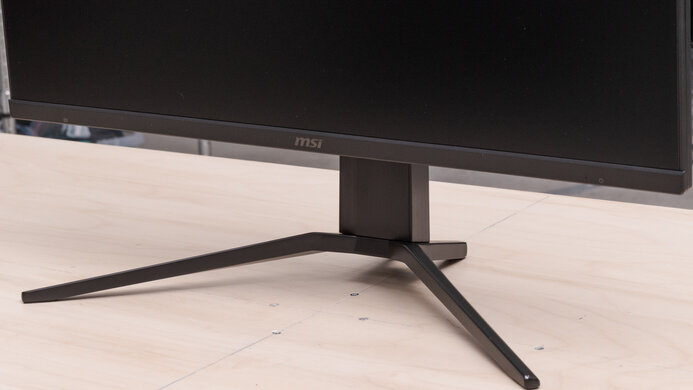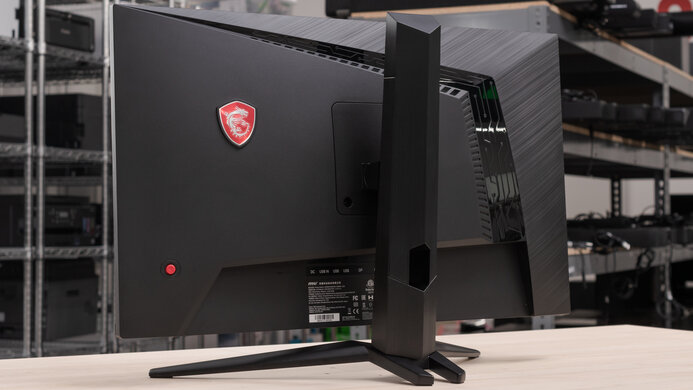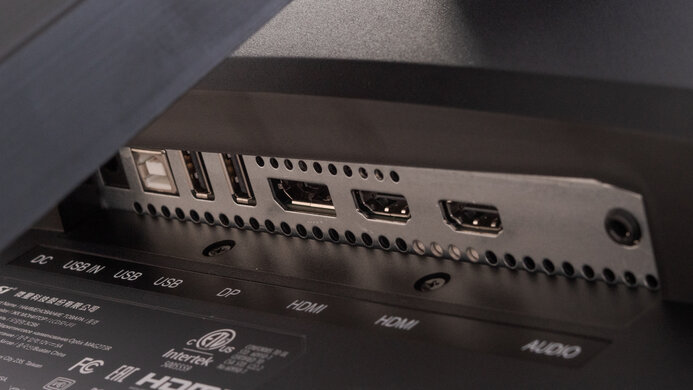The MSI Optix MAG273R is a good IPS monitor with a 27 inch, 1080p screen. The relatively low pixel density isn't great for multitasking or desktop work, but this monitor mainly targets esports players, with a high refresh rate, low input lag, and great response time. It also supports AMD's FreeSync variable refresh rate technology, which helps to reduce screen tearing while gaming. This monitor can get bright enough for most rooms, and it has good reflection handling, so glare shouldn't be an issue. Unfortunately, although the stand has a great height adjustment range and great tilt range, it can't swivel and can't rotate to a portrait orientation. Also, like all IPS monitors, it has a low contrast ratio, so it's not a great choice for a dark room.
Our Verdict
The MSI MAG273R is a good monitor for most uses, but due to the low pixel density, it's not ideal for multitasking or office work. It has low input lag and a great response time, making it a great choice for gaming. It has wide viewing angles, good reflection handling, and good peak brightness, so it looks good in most rooms. Although this monitor supports HDR, it has a low contrast ratio and small highlights can't get very bright, so HDR doesn't add much.
-
Image remains accurate at an angle.
-
Low input lag.
-
Outstanding gradients.
-
1080p resolution isn't ideal at this size.
-
Low contrast ratio.
The MSI MAG273R is a good monitor for office use. It has decent horizontal viewing angles, great height and tilt adjustment, good reflection handling, and good peak brightness. Unfortunately, the 1080p resolution isn't great for multitasking, and it has a low contrast ratio, so it's not a good choice if you often work in a dark room.
-
Image remains accurate at an angle.
-
Low input lag.
-
Outstanding gradients.
-
1080p resolution isn't ideal at this size.
-
Low contrast ratio.
The MSI Optix MAG273R is a great gaming monitor. It has exceptionally low input lag, a fast refresh rate, and a great response time at the max refresh rate. It also supports FreeSync variable refresh rate technology. Unfortunately, it's not as good for console gaming, as the 60Hz response time is just okay, and it's not ideal for late-night gaming due to the low contrast ratio.
-
Image remains accurate at an angle.
-
Low input lag.
-
Outstanding gradients.
-
1080p resolution isn't ideal at this size.
-
Low contrast ratio.
The MSI Optix MAG273R is a good monitor for multimedia. The large screen and wide viewing angles are great for watching videos with a few people. It has good reflection handling and good peak brightness, so glare shouldn't be an issue in most rooms. On the other hand, it has a low contrast ratio, so it's not a good choice if you like watching videos at night.
-
Image remains accurate at an angle.
-
Low input lag.
-
Outstanding gradients.
-
1080p resolution isn't ideal at this size.
-
Low contrast ratio.
The MSI Optix MAG273R is a good monitor for media creation. It has wide viewing angles, excellent gray uniformity, good reflection handling, and excellent gradient handling. It also has an outstanding SDR color gamut, with great coverage of the Adobe RGB color space. Although the stand has a great height and tilt adjustment, it doesn't swivel, so it might not be the best if you often have to turn your monitor to share your screen.
-
Image remains accurate at an angle.
-
Low input lag.
-
Outstanding gradients.
-
1080p resolution isn't ideal at this size.
-
Low contrast ratio.
This is a decent monitor for HDR Gaming, mainly due to its great performance as a gaming monitor. Like most IPS monitors, the MSI Optix MAG273R has a low contrast ratio, and it doesn't have a local dimming feature. It also can't get very bright in HDR, so small highlights don't stand out as much as they should. Overall, HDR just doesn't add much.
-
Image remains accurate at an angle.
-
Low input lag.
-
Outstanding gradients.
-
1080p resolution isn't ideal at this size.
-
Low contrast ratio.
-
Can't get very bright in HDR.
- 7.6 Mixed Usage
- 7.5 Office
- 8.0 Gaming
- 7.6 Multimedia
- 7.6 Media Creation
- 7.0 HDR Gaming
Changelog
- Updated Sep 04, 2020: Review published.
- Updated Aug 31, 2020: Early access published.
- Updated Jul 30, 2020: Our testers have started testing this product.
- Updated Jul 23, 2020: The product has arrived in our lab, and our testers will start evaluating it soon.
- Updated Jul 15, 2020: We've purchased the product and are waiting for it to arrive in our lab.
Check Price
Differences Between Sizes And Variants
We tested the 27" MSI Optix MAG273R, which is part of MSI's Optix MAG Series of gaming monitors that has other models available, some of which are listed below. We don't expect our review to be valid for the other models.
If someone comes across a different type of panel or if their MAG273R doesn't correspond to our review, let us know and we will update the review. Note that some tests such as gray uniformity may vary between individual units.
| Model | Size | Resolution | Refresh Rate | Notes |
| Optix MAG273R | 27" | 1080p | 144Hz | Tilt & Height Adjustment |
| Optix MAG273 | 27" | 1080p | 144Hz | Tilt only |
| Optix MAG271CQR | 27" | 1440p | 144Hz | VA Panel |
The manufacturing date of our unit isn't indicated, but you can see the label here.
Compared To Other Monitors
The MSI Optix MAG273R is a great budget gaming monitor, but it probably won't please more demanding gamers. See our recommendations for the best budget gaming monitors, the best 27 inch monitors, and the best 1080p monitors.
The MSI Optix MAG271CQR and the MSI Optix MAG273R use different panel technologies, each with their own strengths and weaknesses. The MAG271CQR has a much better contrast ratio, and a higher resolution screen, making it a better choice overall for office use or if you're in a dark room. On the other hand, the MAG273R has wider viewing angles, much better gradient handling, and it supports HDR, although this doesn't add much.
The MSI Optix MAG273R is marginally better than the Gigabyte G27QC overall. The MSI has much better viewing angles, faster response time, and a Black Frame Insertion feature. However, the Gigabyte has a higher resolution, a higher refresh rate, and its VA panel has a better contrast ratio.
The LG 27GL650F-B and the MSI Optix MAG273R are very similar overall. The LG has slightly better ergonomics and better horizontal viewing angles, and it has much better accuracy out of the box. The MSI that we tested has better black uniformity, but this varies between units, so it might not be an actual difference.
The MSI Optix MAG273R has better ergonomics than the Acer Nitro VG271 Pbmiipx, but if that's not important to you, the Acer has slightly better picture quality and better motion handling. The Acer is brighter, it has a much better response time when gaming at 60Hz, and it's more accurate out of the box.
The ASUS VG279Q is slightly better overall than the MSI Optix MAG273R. The ASUS has better horizontal viewing angles and much better ergonomics, so it might be easier to place it in an ideal viewing position. On the other hand, the MSI supports HDR and has better gradient handling, although the former doesn't add much, as it can't get very bright in HDR.
The MSI Optix MAG273R is much better than the MSI Optix G27C5. The MAG273R has an IPS panel, so it has much wider viewing angles. It also has better ergonomics, it supports HDR, and it has a quicker response time at its max refresh rate. However, the VA panel on the G27C5 displays deeper blacks, it has better color accuracy, and its response time at 60Hz is better.
The MSI Optix MAG273R is better than the LG 32GN50T-B for most uses. The MSI has an IPS panel with much wider viewing angles, better gradient handling, and it can display a wide color gamut for HDR content, which the LG can't. It has a smaller screen, but that means it has a higher pixel density to produce sharper images. On the other hand, the LG has a VA panel with a much higher contrast ratio, making it a better choice for dark rooms, and it gets a bit brighter overall.
The MSI Optix MAG273R is better overall than the MSI Optix G27C6, but they have different panel types. The MAG273R has an IPS panel with wider viewing angles, while the G27C6 is better for dark room gaming because its VA panel has a higher contrast ratio. Even though the G27C6 has a higher 165Hz refresh rate compared to 144Hz, the MAG273R has quicker response times for better motion handling. It also supports HDR, which the G27C6 doesn't, but it doesn't add much because it doesn't get bright enough to make highlights pop.
Test Results
The MSI Optix MAG273R has a simple design, with thin bezels and a claw-shaped stand. The stand has a large footprint, but it supports the monitor well, with very little wobble. There are a few nice design touches on the back as well, including a strip of RGB lighting.
The stand is very similar to the MSI Optix MAG271CQR. It has a large footprint, but overall, it's well-built and supports the monitor well.
The back has a nice design to it, with a chevron pattern and RGB lighting along the top. There's a cutout in the stand for cable management, but no quick release.
Like all IPS monitors, the MSI MAG273R has a low contrast ratio, so it's not a great choice for a dark room. If you want a similar monitor that's better suited for dark rooms, check out the Dell S2721HGF.
This monitor doesn't have a local dimming feature. The video is provided for reference only.
Good peak brightness in SDR. The MSI Optix MAG273R is bright enough for pretty much any viewing environment. It's not quite as bright as the MSI Optix MAG271CQR we tested, but they use different panel types, so this is expected.
The peak brightness listed by MSI for this monitor is only 250 nits. We don't know if our unit is exceptionally bright, or if MSI's specifications list the minimum they expect for the panel. If you have this monitor and are able to measure the peak brightness, let us know what you get in the discussions below.
Okay peak brightness in HDR. It's a bit brighter than SDR, but highlights don't stand out the way they should with HDR content.
Typical for IPS monitors, the image remains accurate even when viewed from the side. This is great for sharing the screen with other people.
The vertical viewing angle is okay. Most people won't notice any issues, but if you're sharing the screen with someone standing beside you, they won't see the same image as you.
The MSI MAG273R has excellent gray uniformity. The sides of the screen are darker than the center, and our unit has a slightly darker line near the center of the screen, but these aren't very noticeable with regular content. The uniformity is even better in near black scenes, with almost no dirty screen effect (DSE). Gray uniformity can vary between units, but most monitors have great uniformity overall.
Unfortunately, the MSI MAG273R has disappointing accuracy out of the box. Gamma is almost flat, closer to 2.1 than the sRGB target curve, so most content is displayed brighter than it should be. There are noticeable inaccuracies in most colors, and the color temperature is warm. Note that this does vary between units, so let us know if you get a better one.
After calibration, the MSI Optix MAG273R has much better accuracy. Gamma follows the sRGB target curve almost perfectly, and there are no noticeable inaccuracies in any color. The white balance is also very close to the calibration target.
You can download our ICC profile calibration here. This is provided for reference only and shouldn't be used, as the calibration values vary per individual unit even for the same model due to manufacturing tolerances.
Outstanding SDR color volume. With nearly perfect coverage of the sRGB color volume, this monitor is limited mainly by its inability to produce dark, saturated colors due to the low contrast ratio. Pure blues aren't as bright as other colors either, but this is common for LED displays.
This monitor has a very good HDR color gamut and exceptional coverage of the DCI P3 color space used by most HDR content. P3 coverage is higher than any other monitor we've tested since the MSI MAG273R doesn't tone map to try and compress colors that fall outside the P3 color space. Instead, it clips anything that it can't display, resulting in a loss of details. This is fine if you mainly work with content mastered in DCI P3, but if your content is mastered in Rec. 2020, any details outside of its color gamut will be lost.
There are no signs of temporary image retention, but this can vary between units. Let us know in the discussions below if you have this monitor, and have noticed image retention.
| Overdrive Setting | Response Time Chart | Response Time Tables | Motion Blur Photo |
| Normal | Chart | Table | Photo |
| Fast | Chart | Table | Photo |
| Fastest | Chart | Table | Photo |
Great response time at the max refresh rate. There's a bit of overshoot when transitioning to a brighter shade, causing a slight halo effect behind fast-moving objects. This can be seen behind the 'R' in our moving-logo photo above. If the overshoot bothers you, the 'Fast' setting has only slightly slower response time, but has significantly less overshoot.
| Overdrive Setting | Response Time Chart | Response Time Tables | Motion Blur Photo |
| Normal | Chart | Table | Photo |
| Fast | Chart | Table | Photo |
| Fastest | Chart | Table | Photo |
The 60Hz response time is okay, but there's a bit more noticeable blur behind fast-moving objects. We recommend the 'Normal' overdrive setting, as it offers the best overall performance. The Rise / Fall Time is significantly faster on 'Fast' or 'Fastest', but there's also significantly more overshoot, causing the total response time to actually increase compared to the 'Normal' setting.
The MSI MAG273R has an optional Black Frame Insertion (BFI) feature, but unfortunately, it's only available close to the maximum refresh rate. Below 120Hz, it doesn't work. Unlike some ASUS monitors, like the ASUS VG279QM, BFI can't be used when FreeSync is enabled.
This monitor's high refresh rate is excellent for gaming, but even desktop users will appreciate it. It supports AMD's FreeSync variable refresh rate technology, and although it's not officially certified, we were able to enable NVIDIA's G-SYNC Compatible mode. Note that G-SYNC Compatible mode only works over DisplayPort and that it requires at least a 10-Series NVIDIA graphics card.
Outstanding low input lag, resulting in an extremely responsive gaming experience. We were only able to test the 10-bit HDR input lag at 120Hz, as that's the maximum refresh rate supported over HDMI with HDR enabled, and our HDR input lag test can only be done over HDMI.
While some esports players may prefer the low resolution of this screen, as it's easier to maintain a high framerate, it's not ideal for multitasking or desktop use. If you want something with a higher 1440p resolution, look into the MSI Optix MAG274QRF-QD.
The MSI MAG273R has a few additional features, most of which are designed with gamers in mind. MSI's Gaming OSD 2.0 allows you to control most of the monitor's settings, including the customizable RGB backlighting. Through the OSD you can also add virtual crosshairs to any game.
The joystick control at the back of the monitor is very easy to use, but might be hard to reach, especially if VESA-mounted. If you don't want to use the controls, most settings can also be adjusted through the Gaming OSD 2.0 software, as long as the monitor is connected to your computer with the USB-B cable.
Comments
MSI Optix MAG273R: Main Discussion
Let us know why you want us to review the product here, or encourage others to vote for this product.











































































































